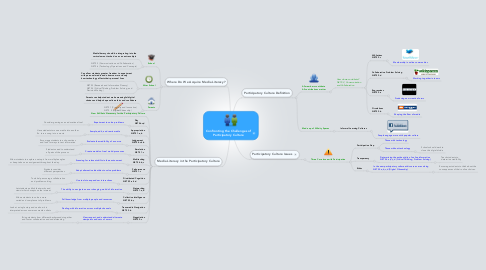
1. Media Literacy in the Participatory Culture
1.1. New Skill Sets Necessary for the Participatory Culture
1.2. Play NETS6.c,d
1.2.1. Experiment to solve problems
1.2.1.1. Consider gaming as an educational tool
1.3. Appropriation NETS 1.a,b
1.3.1. Sample, edit, and remix media
1.3.1.1. Have students turn one media into another. Ex. turn a song into a movie
1.4. Judgement NETS 4.c 6.b
1.4.1. Evaluate the credibility of a source
1.4.1.1. Encourage students to ask questions and look for ways to test information
1.5. Simulation NETS 1.c
1.5.1. Create models of real world processes
1.5.1.1. Students need to understand all parts of the process
1.6. Multitasking NETS 4.b,c
1.6.1. Scanning for relevant shifts in the environment
1.6.1.1. Allow students to explore one topic from multiple angles or keep tabs on an assignment throughout the day.
1.7. Performance NETS 1.c
1.7.1. Adopt alternative identities to solve problems
1.7.1.1. Students consider different perspectives
1.8. Distributed Cognition NETS 2.a 4.d
1.8.1. Use tools to expand our interactions
1.8.1.1. Tools help encourage collaboration and problem solving
1.9. Networking NETS 1.a,d
1.9.1. The ability to navigate an ever changing world of information
1.9.1.1. Let students publish their works and view similar concepts on the internet
1.10. Collective Intelligence NETS 3.b,c
1.10.1. Pull knowledge from multiple people and resources
1.10.1.1. Allows students to solve a more varied and complex set of problems
1.11. Trans-media Navigation NETS 3.b
1.11.1. Dealing with information across multiple channels
1.11.1.1. Look at a single story and see how it is interpreted across numerous media outlets
1.12. Negotiation NETS 2.c
1.12.1. View, respect, and understand alternate viewpoints and sets of norms
1.12.1.1. Bring students from different backgrounds together and foster collaboration and understanding
2. Where Do We Acquire Media Literacy?
2.1. School
2.1.1. Media literacy should be integrating into the curriculum not tacked on as an extra subject
2.1.2. NETS 2 (Communication and Collaboration) NETS 6 (Technology Operations and Concepts)
2.2. After School
2.2.1. Can allow students greater freedom to experiment with personal media and observe more closely how technology effects their personal lives
2.2.2. NETS 3 (Research and Information Fluency) NETS 4 (Critical Thinking, Problem Solving, and Decision Making)
2.3. Parents
2.3.1. Parents can help student make meaningful digital choices and help shape online ethics and confidence
2.3.2. NETS 1 (Creativity and Innovation) NETS 5 (Digital Citizenship)
3. Participatory Culture Issues
3.1. Three Core Issue with Participation
3.1.1. Participation Gap
3.1.1.1. Those with technology
3.1.1.2. Those without technology
3.1.1.2.1. Schools should work to close this digial divide
3.1.2. Transparency
3.1.2.1. Determining the authenticity of online information NETS 4.a,b,c,d (Critical Thinking, Problem Solving)
3.1.2.1.1. Teach students to determine credibility
3.1.3. Ethics
3.1.3.1. In the new participatory culture ethics are ever evolving NETS 5.a,b,c,d (Digital Citizenship)
3.1.3.1.1. Encourage students to think about the consequences of their online choices.
4. Participatory Culture Definition
4.1. All members contribute All contributions matter
4.1.1. How do we contribute? NETS 2, Communication and Collaboration
4.1.1.1. Affiliations NETS 2.c
4.1.1.1.1. Membership in online communities
4.1.1.2. Collaborative Problem Solving NETS 2.d
4.1.1.2.1. Working together in teams
4.1.1.3. Expressions NETS 2.a
4.1.1.3.1. Producing new creative forms
4.1.1.4. Circulations NETS 2.b
4.1.1.4.1. Shaping the flow of media
4.2. Made up of Affinity Spaces
4.2.1. Informal Learning Cultures
4.2.1.1. People engage more with popular culture
